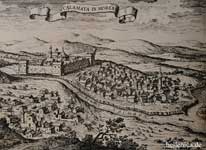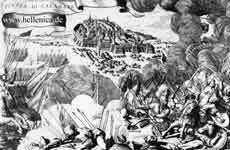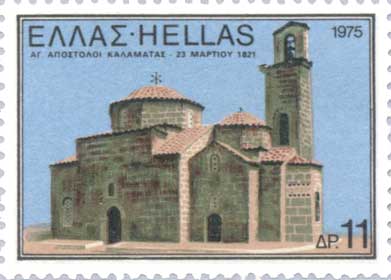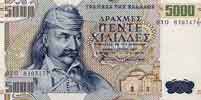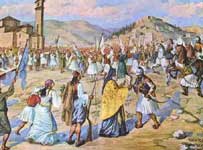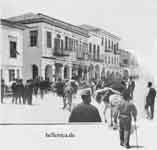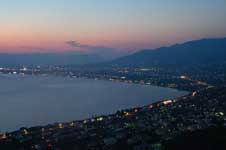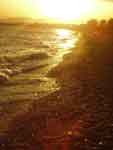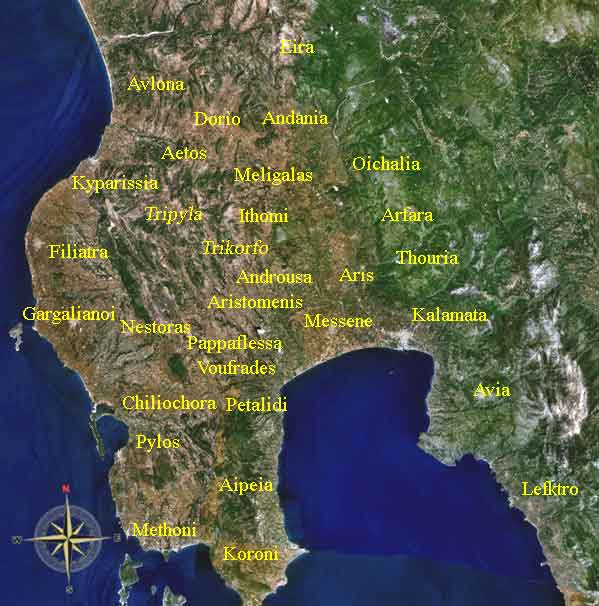.
Administrative Region : Peloponnese
Regional unit : Messinia
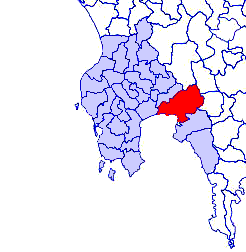
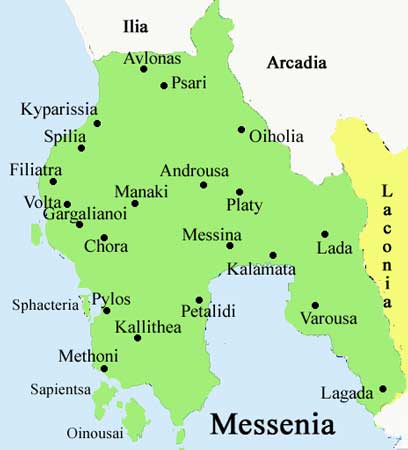
Kalamata (Greek: Καλαμάτα Kalamáta, formerly Καλάμαι Kalámai) is the second-largest city of the Peloponnese in southern Greece. The capital and chief port of the Messenia prefecture, it lies along the Nedon River at the head of the Messenian Gulf. Located near the ancient city of Pharai mentioned by Homer, it lies 238 km (148 mi) SW of Athens, about 60 km (37 mi) SE of Kyparissia and GR-9, about 120 km (75 mi) SSE of Pyrgos, about 80 km (50 mi) SW of Tripoli, about 60 km (37 mi) W of Sparta, NW of Areopoli and about 8 km (5.0 mi) E of Messene, it is also 215 km (134 mi) south of Patras and 715 [old: 750] kilometres (444 mi) south of Thessaloniki. The 2001 census recorded 57,620 inhabitants, but it is a busy city and on a regular daily basis there are more than 85,000 people working and circulating in it.
Kalamata is renowned as the land of the Kalamatianos dance and the silk kerchief; of succulent dark olives, honey-eyed figs and the honey-covered sesame sweet called pasteli. The city can be reached from other Greek cities by bus and train. Furthermore, the city has an international airport and an important harbour. Ferries are available to places such as the Greek islands of Kythira, and Crete .
The Messenian Gulf where Kalamata is located has various long beaches. The Taygetus mountain range is located about 4 km (2.5 mi) E of Kalamata and GR-82 Kalamata – Sparta highway runs through the ranges.
Olives and olive oil are important and famous products that are exported from Kalamata.
Kalamata has schools, lyceums, gymnasia, banks, a post office, and squares (plateia). The newly established University of the Peloponnese has a campus in Kalamata, where the history, literature, religion and philosophy departments are located. The Kalamata campus of the university also provides free Greek lessons to expatriate Greeks. The TEI of Kalamata is also located in the city.
Name
The name Kalamata may be related with the Greek phrase καλά μάτια kala matia which means beautiful eyes. A Byzantine church near the city is devoted to the virgin of Kalo Matia where there was a devastating historic fire and the Icon of the Virgin Mary remained with minor burned edges and classically beautiful and loving eyes. There is a place with the name "Kala Mata"[1] on the island of Mallorca in Spain. In Sardinia, Italy, close to Cagliari, there is a place called "Surcuri-Calamata".[2] The origin of the name of these places is Greek and has to do with the word's Καλά "Kala" meaning good or beautiful and Μάτα "Mata" or matia meaning eyes.
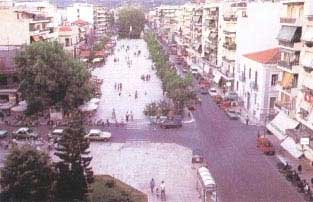
Central Square of Kalamata *
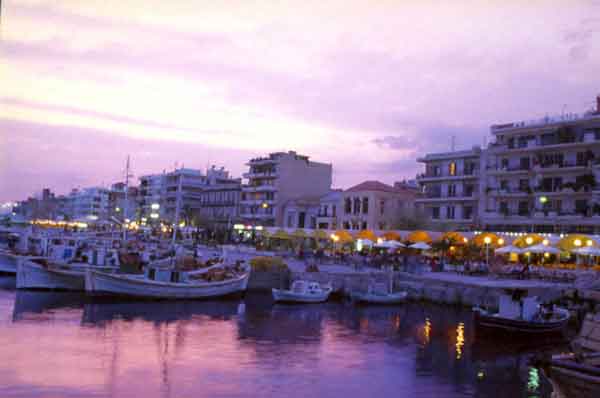
Kalamata (Source)
Municipality
The municipality Kalamata was formed at the 2011 local government reform by the merger of the following 4 former municipalities, that became municipal units:[3]
Arfara
Aris
Kalamata
Thouria
Subdivisions
The municipal unit of Kalamata is subdivided into the following communities (population according to the 2001 census and villages within the district in brackets):
Alagonia (pop: 360, Alagonia, Machalas)
Antikalamos (pop: 541)
Artemisia (pop: 291, Artemisia, Theotokos)
Asprochoma (pop: 1,231, Asprochoma, Akovitika, Kalami, Katsikovo)
Elaiochori (pop: 395, Elaiochori, Arachova, Diasella, Moni Dimiovis, Perivolakia)
Kalamata (pop: 49,550, Kalamata, Bournias, Koutala, Menina, Profitis Ilias, Moni Velanidias)
Karveli (pop: 180, Karveli, Agia Triada, Emialoi, Kato Karveli)
Ladas (pop: 223, Ladas, Agia Marina, Agios Vasileios)
Laiika (pop: 926, Laiika, Katsaraiika, Spitakia, Xerokampi)
Mikri Mantineia (pop: 688)
Nedousa (pop: 158)
Piges (pop: 103, Piges, Skouroulakkos)
Sperchogeia (pop: 855)
Verga (pop: 2,110, Ano Verga, Kato Verga, Paralia Vergas)
History
View of the fortress.
Unlike many other Greek cities, Kalamata does not date to classical times. However, Messene, located some 25 km (16 mi) north-west of Kalamata and about 15 to 20 km (12 mi) from modern Messini, is an important ancient site. From 1681 on the Venetians ruled Kalamata. On 23 March 1821, Kalamata was the first city to be liberated from the Ottoman occupation of over 300 years, by the Greek revolutionary forces under the command of generals Theodoros Kolokotronis, Petros Mavromichalis and Papaflessas. In 1825, Ibrahim Pasha destroyed the city during the Greek war of independence. After this, Kalamata was rebuilt and became one of the most important ports in the Mediterranean sea. It is not surprising that the second-oldest Chamber of Commerce in the Mediterranean, after that of Marseille, exists in Kalamata. On 29 April 1941, a battle was fought near the port between invading German forces and the 2nd New Zealand Division, during which Jack Hinton was awarded the Victoria Cross. After World War II, and due to political issues, Kalamata, as well as most of the Peloponnese, was excluded from the government development plans in favour of north Greece. That was a major brake on the local economy, resulting in the decline of the port and hence the city. During 70s and the 80s, development and growth in Kalamata were unknown, and only after the city suffered severe damage from the earthquakes of 13 September 1986, the local authorities and individuals strained their financial resources to bring a wind of change to the forgotten capital of Messinia. Due to these efforts, Kalamata has now fully recovered and developed into a modern provincial capital, with all facilities and amenities, as well as one of the most modern hospitals in Greece. It is also the seat of the Metropolitan Bishop of Messinia. Current Metropolitan Bishop is Chrysostomus III since 15 March 2007.
Kalamata was under Frankish occupation between 1205 and 1381, ruled by the French Villehardouin family (1210 to 1278) from the castle they built. Later occupied by the Turks from 1481 to 1685 like the rest of Greece, the city was next taken over by the Venetians in 1685. During the Venetian occupation the city was fortified, developed and thrived economically. However, the Turks reoccupied Kalamata in 1715 and controlled it until the Greek War of Independence of 1821 when Petrobeis Mavromihalis liberated the city. Kalamata was again in the news and headlines on Saturday, 13 September 1986, as an earthquake measured at almost 6.6 on the Richter scale. The earthquake, although, moderately strong-reported caused heavy damage and killed 20 people.[4]
Today, Kalamata has the second largest population and mercantile activity in Peloponnese. It makes important exports, particularly of local products such as raisins, olives and olive oil. Although the city experienced catastrophic consequences after the earthquake of 1986, it has overall recovered its pace and is forging ahead successfully from a commercial aspect.
There are numerous historical and cultural sights in Kalamata, such as the Villehardouin castle, the Ypapandis Byzantine church, the Kalograion monastery with its silk-weaving workshop where the Kalamata scarves are made, and the municipal railway park. Mavromihalis declared the revolution in the church of Agion Apostolon. Art collections are housed at the Municipal Gallery, the Archaeological Museum of Messenia and the Folk Art Museum.
|
Agioi Apostoloi church, declaration of the independence war, 23.3.1821 |
|
Sights in and around Kalamata
Church of the Ypapandi
Kalamata’s Metropolitane Church of the Ypapandi nestles beneath the 14th century Frankish castle. The foundation stone was laid in 1860 and it was inaugurated in 1873. During the 1963 earthquake it suffered great damage and was restored. The Festival of the Ypapandi is of national importance for the Greek world and, locally, the occasion for a holiday. The litany of the miraculous Icon was confirmed in 1889 and takes place in any weather.
In late January 2010 the city hosted the Ecumenical Patriarch Bartholomew to celebrate the 150th anniversary of the Ypapandi of Christ Church. He was offered the Golden Key of the city. The region around Kalamata has provided two Ecumenical Patriarchs in the past.
Transportation
The railway station.
It is accessed by GR-7/E55/E65 in the west and GR-82 runs through Kalamata and into the Taygetus. The nearest motorway is now 35 km (22 mi) N. From the mid-1980s until 2002, it was 85 km (53 mi) SW in Tripoli. There is a road connecting within the coastline of Kalamata which is not far from the gulf and runs in the southern part of Kalamata.
Kalamata is served by a metre gauge railway line of the former Piraeus, Athens and Peloponnese Railways, now owned by the Hellenic Railways Organisation (OSE). There is a passenger train station and a small freight yard in the city, as well as a rolling stock maintenance depot to the north. A disused extension line to the port is now used as a Railway Park. Currently there are mainline train services to Kyparissia, Pyrgos and Patras, and suburban services to Messini and the General Hospital. There are no passenger services to Corinth (Korinthos) via Tripoli and Argos, due to extensive track reconstruction work.
There is a bus link (KTEL) to Tripoli, Korinthos and Athens with frequent services.
Since the mid-80s there has been a regular weekly cruise-boat route between Kalamata – Kythira – Chania (Crete). In the summer months charter flights fly direct to Kalamata International Airport from some European cities. A scheduled service by Aegean Air twice a day linking Kalamata and Athens International Airport commenced in May 2010.
Historical population
Year Town population Municipality population
1981 42,075 –
1991 43,625 50,693
2001 61,373 81,125
Landmarks
Benakeion Archaeological Museum of Kalamata,[5] located in the heart of the historical centre of Kalamata.
Byzantine churches
Cultural events, such as the International Dance Festival
Kalamata International Dance Festival
The Castle of Kalamata from the 13th century AD.
The Marina and the Port of Kalamata, located SW of the city centre. It is the main and largest port in Messinia and the southern part of the Peloponnese.
Kalamatas National Stadium – home of Messiniakos, it contains 5,000 spectators
The Kalamata International Airport, an airport located about 7 km (4.3 mi) NW, close to Messene. The runway length is about 2 km (1.2 mi) and it is combined with a military airport.
The Railway Museum of the Municipality of Kalamata,[6] a railway museum which first opened since 1986
Ancient Messene, some 15 to 20 km (12 mi) north-west of modern Messini
The Temple of Apollo Epicurius, about two hour's drive north from Kalamata
Tourist information
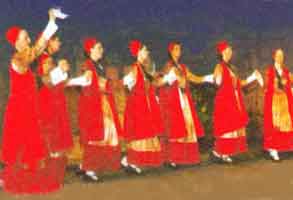
Notable people
William II of Villehardouin (d. 1278) the last Villehardouin prince of Achaea
Yiannis Balis (1932) Physician Scientist, Discoverer of Lamellar bodies and their associated function
Yiannis Chryssomallis ("Yanni") (1954) composer and musician
Aggeliki Daliani (1979) actress
Nikolaos Doxaras, painter
Panagiotis Doxaras, painter
Andreas Apostolopoulos (1952) Real estate developer and sports team owner
Alexandros Koumoundouros, Prime Minister of Greece in the 19th century
Gerasimos Michaleas (1947) Orthodox Christian Metropolitan bishop of San Francisco, California, USA
Panos Mihalopoulos (1949) actor
Nikolaos Georgeas (1976) footballer
Nikolaos Lyberopoulos, (1975) footballer
Sokratis Papastathopoulos (1988) footballer
Kenny Stamatopoulos (1979) footballer
Prokopis Pavlopoulos (1950) lawyer, university professor and politician
Vassilis Photopoulos (1934–2007) painter, film director, art director and set designer
Nikolaos Politis, folklorist
Maria Polydouri (1902–1930) poet
Michail Stasinopoulos (1903–2002) lawyer, President of the Republic of Greece
Panagiotis Moragiannis (1976) Greek-Australian Politician
Sporting teams
Apollon Kalamatas
Kalamata FC – second division
Messiniakos fc – third division
Olympiakos Kalamatas
Prasina Poulia Kalamata (literally the Green Bird)
International relations
See also: List of twin towns and sister cities in Greece
Twin towns — Sister cities
Kalamata is twinned with:
Lebanon Amioun, Lebanon
Cyprus Aglantzia, Cyprus
Tunisia Bizerte, Tunisia
China Xi'an, China[7]
See also
Kalamata (olive)
Kalamatianó
Communities of Messenia
|
Municipalities and communities of the Messinia Prefecture
Aetos | Aipeia | Andania | Androusa | Arfara | Aris | Aristomenis | Avia | Avlona | Chiliochora | Dorio | Eira | Filiatra | Gargalianoi | Ithomi | Kalamata | Koroni | Kyparissia | Lefktro | Meligalas | Messene | Methoni | Nestoras | Oichalia | Pappaflessa | Petalidi | Pylos | Thouria | Voufrades |
Greece :
A - B - C - D - E - F - G - H - I - J - K - L - M -
N - O - P - Q - R - S - T - U - V - W - X - Y - Z
| Ancient Greece
Science, Technology , Medicine , Warfare, , Biographies , Life , Cities/Places/Maps , Arts , Literature , Philosophy ,Olympics, Mythology , History , Images Medieval Greece / Byzantine Empire Science, Technology, Arts, , Warfare , Literature, Biographies, Icons, History Modern Greece Cities, Islands, Regions, Fauna/Flora ,Biographies , History , Warfare, Science/Technology, Literature, Music , Arts , Film/Actors , Sport , Fashion --- |
References
^ "Playa Cala Mata en Artà.". Queplaya.es. Retrieved 2009-09-21.
^ "City of San Basilio Province of Cagliari Sardinia City Villas localities Guide of Sardinia Sardinien Sardegna Cerdena Sardaigne". Paradisola.com. Retrieved 2009-09-21.
^ Kallikratis law Greece Ministry of Interior (Greek)
^ http://dx.doi.org/10.1193/1.1585434
^ [1][dead link]
^ "Hellenic Ministry of Culture | Railway Museum of the Municipality of Kalamata". Odysseus.culture.gr. Retrieved 2009-09-21.
^ "China's Xi'an forges sister city ties with Greece's Kalamata _English_Xinhua". News.xinhuanet.com. Retrieved 2009-09-21.
Retrieved from "http://en.wikipedia.org/"
All text is available under the terms of the GNU Free Documentation License


